Discover how Affectiva’s Facial Coding revealed why Tide’s emotionally-driven ad campaign resonated with audiences and boosted social media engagement. Explore the connection between facial expressions, impactful storytelling, and the effectiveness of Tide’s marketing strategy in driving brand interaction and recall.
Table of Contents
Tide Cleans Up at Cannes
During 2024’s Cannes Lions Festival of Creativity, P&G and Saatchi & Saatchi received a number of accolades including two Gold Lions for Brand Storytelling and Consumer Goods, a Silver Lion for Use of Humour and a Bronze Lion for Innovative Use of Creators, Influencers or Celebrities for their Tide Pod advertisement You’re Gonna Need More Tide.
In the ad, actor Kumail Nanjiani is inserted into a variety of messy situations captured as home videos – a couple learning they’re having triplets, babies and puppies making messes in the house, falling in a deep puddle – all to highlight their key message that Tide Pods now come with 85% more Tide to help effectively clean up these messes.
Given the trending theme of deep cleaning and reorganization videos on social media, the Tide Pods campaign followed that momentum, gearing the campaign more towards Millennials and Gen Z consumers. And in doing so, the You’re Gonna Need More Tide campaign also included social media content, unique AR lenses, and user-generated content from influencers.
What piqued our interest was that this was a unique take on a laundry detergent ad and wanted to understand its success in how the advert was able to secure a number of awards. Our team independently tested this ad with our Affectiva Facial Coding for Ad Testing solution to see how people were emotionally engaging with the creative, and if the Tide Pods branding resonated with viewers.
Lots of smiles + some cringe = positive engagement?!
When looking at the facial coding on an aggregate audience level, we see that viewers are positively engaged with the ad – as noticed by the high levels of Smile (below) – especially during the viral clip buildup leading into the final branding moment. What makes the ad great is that with most of these incidents, we can relate to in our daily lives with our own messes and spills.
The ‘home video’ natural style of viral clips effectively maintained comedic momentum, with the highest peak occurring with the exploding soda bottle erupting on someone’s face.
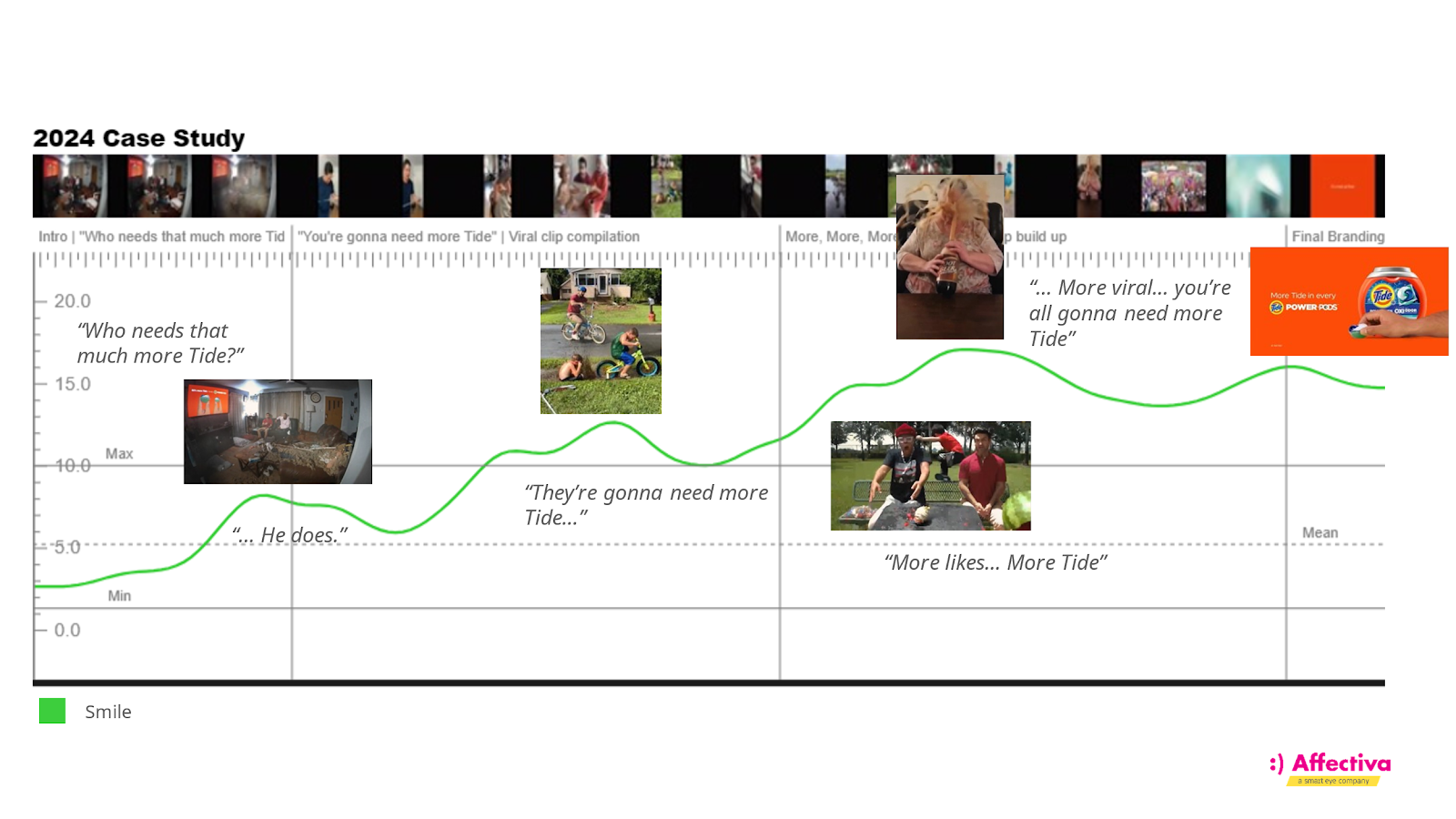
With all these accidents taking place in the ad, signs of negativity emerged in the facial coding data. When we segmented the results by ad likeability, we found that those who claimed that they enjoyed the ad a lot showed higher signs of Nose Wrinkle and Lid Tighten (below, blue), indicating some disgust and cringing at the constant barrage of fails, falls and spills.
Given the nature of the content and its intent, we found that these expressions – albeit typically negative leaning – served as a positive contribution towards liking the ad. Our takeaway: having negativity isn’t necessarily a bad sign for an ad. It all depends on the content type and whether there can be a positive resolution at the end that accompanies the final branding to build saliency.
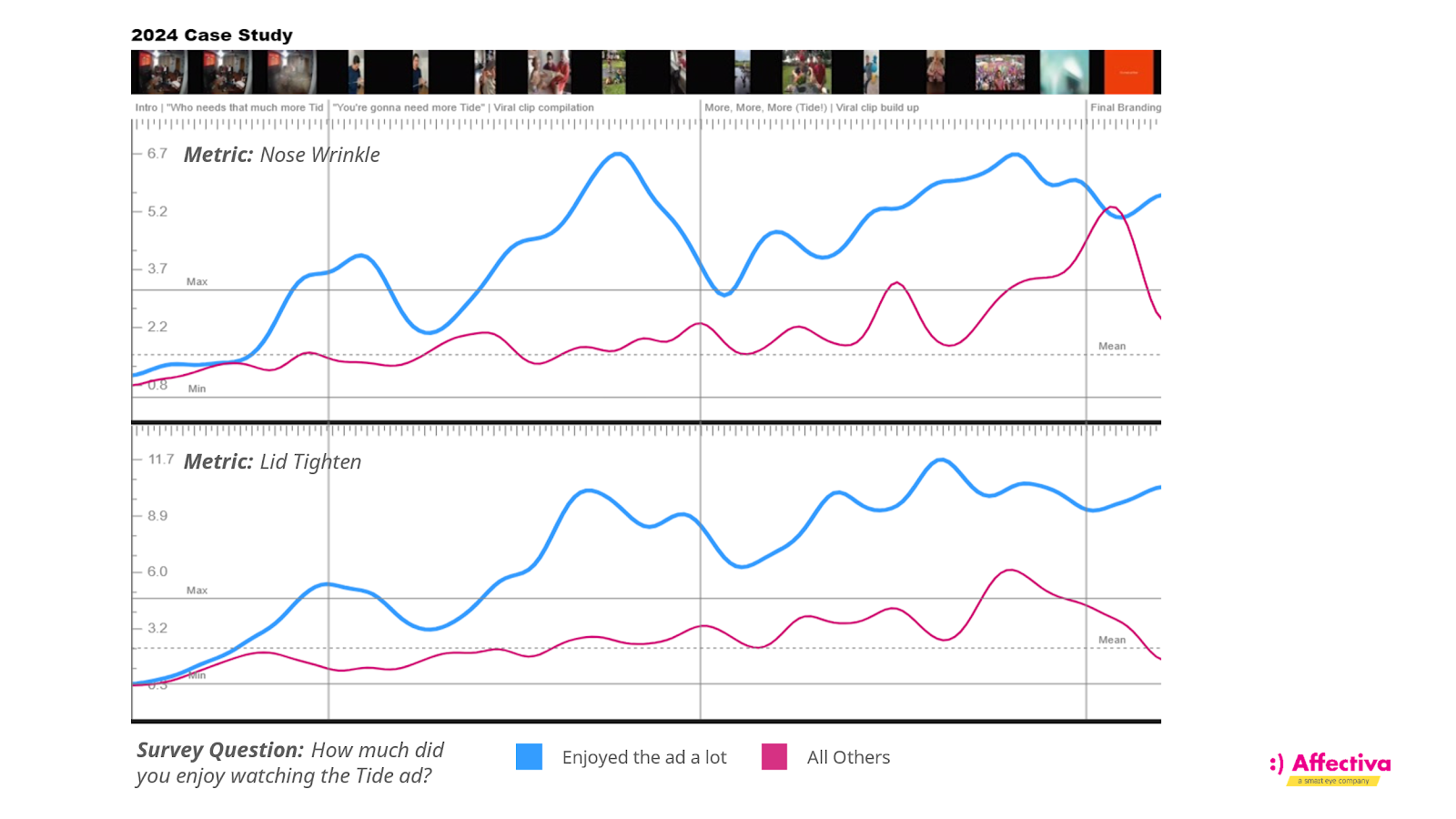
Understanding the Millennial and Gen Z consumer
The goal of the You’re Gonna Need More Tide campaign was to appeal to younger audiences to strengthen Tide brand awareness and affinity. When segmenting data by age ranges and looking at Valence (net positivity), those who identify in the 18-34 age bracket (dark pink) had higher positive valence than those in the older age ranges (35-49 years, yellow; 50-64 years, red) were more positively responding to the content.
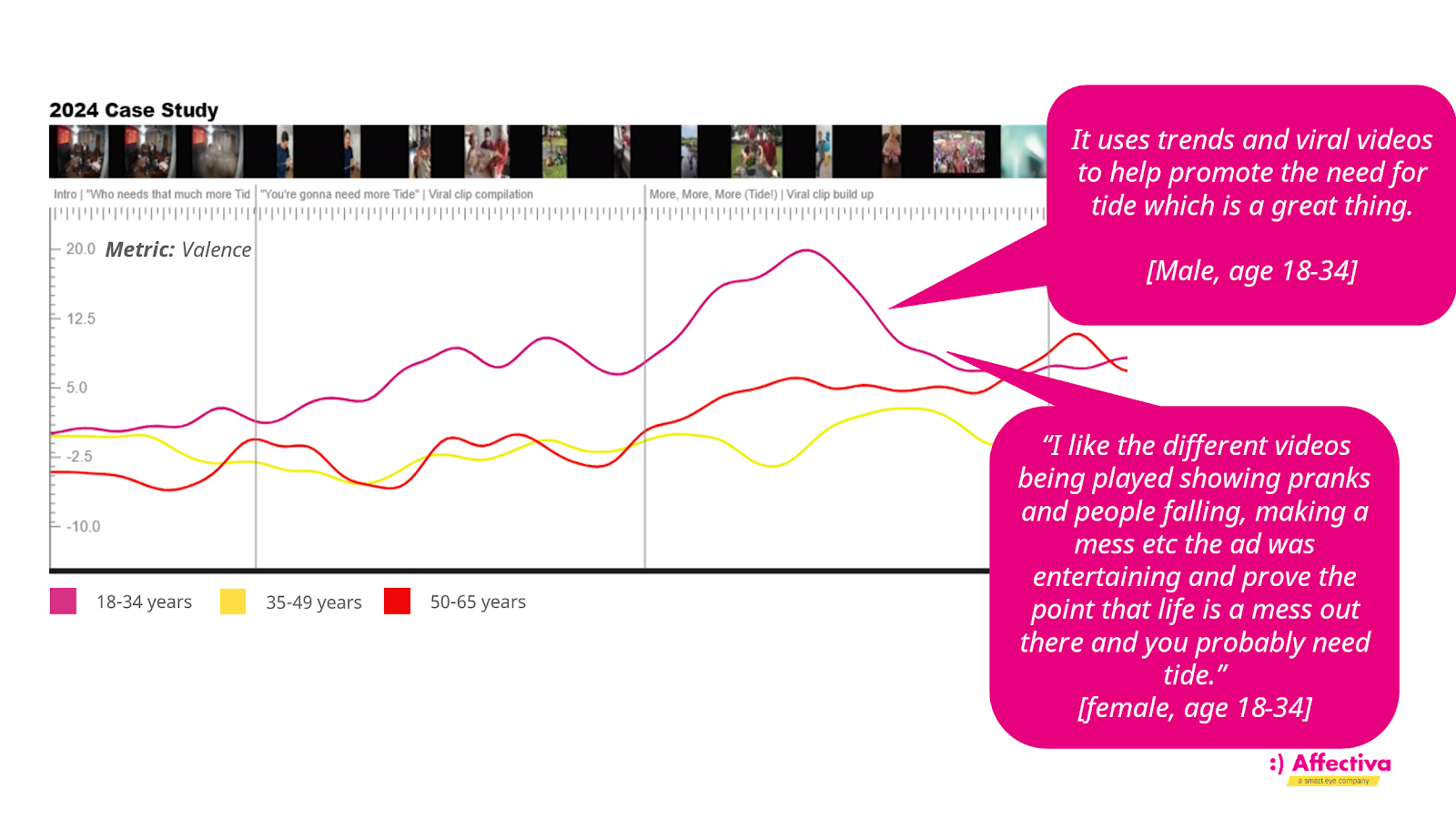
Looking at the open-ended survey responses, many enjoyed the fact that Kumail Nanjiani was in the ad, being a recognizable actor. For Millennials and Gen Z, the ad was innovative in incorporating viral videos and managed to build an entertaining and relatable storyline that effectively connects to the brand.
Did the creative approach pay off? A look into Affectiva’s benchmarks
In our Affectiva ad testing dashboards, we benchmark how a tested video had performed against other videos fielded in a specific fieldwork market. We can explore this further via category norms to understand how this video is compared to other laundry ads within the market.
When comparing across ad, market norm and category norm scores, we can see that the Tide ad was quite positively received (positive valence) and had great engagement (high expressiveness score) by viewers (below).
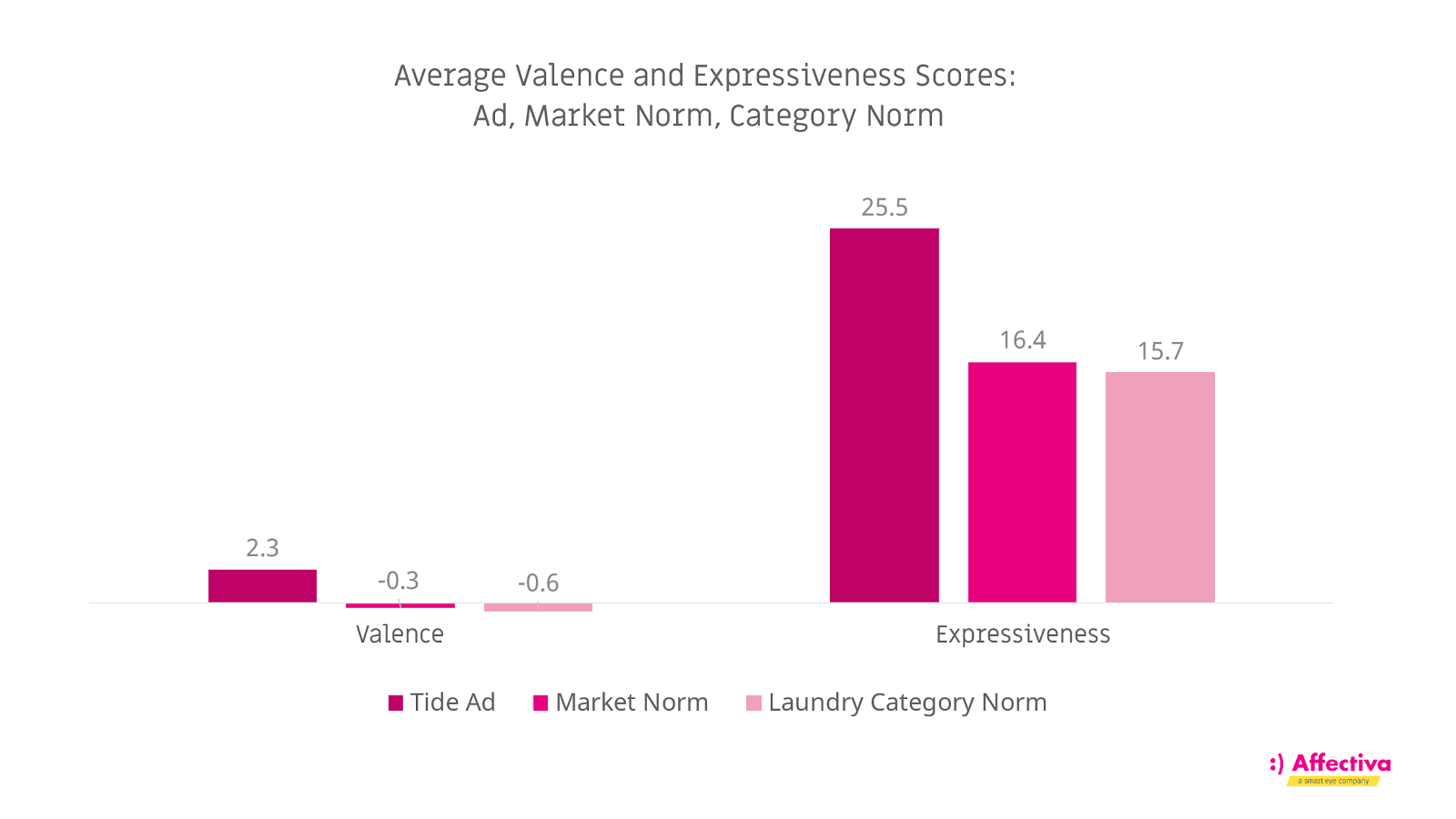
While different from the more traditional laundry ads that may allocate more focus on product benefits or perhaps a heartwarming narrative, the humorous and more novel approach of You’re Gonna Need More Tide paid off, proving to be a success in engaging consumers.
The power of generating a human and relatable connection
You’re Gonna Need More Tide was truly a success and well-deserving of all the awards and buzz. By using facial coding, we can pinpoint how people respond to humorous advertising, and when combining facial coding and survey responses, we can deep dive into the ad’s efficacy in generating stronger brand awareness.
Here are some strategic takeaways that we can learn from You’re Gonna Need More Tide:
- Ad creatives must think outside the box when it comes to establishing brand awareness with younger generations to create and foster a strong connection between consumers, influencers and brands to communicate brand benefits and usage.
- User-generated content is here now and is here to stay; it’s relatable, fun and more natural. Advertising campaigns should draw upon that to build interest with younger audiences who now have buying power for a brand’s goods and services.
- Advertising does not necessarily need to be chock full of information – center on one key message to create a memorable link between consumer and product.
- Remember that the emotional journey does not have to be smiles all the way through. Negativity, when implemented in a humorous and creative way, can prove to be beneficial in generating positive engagement.
Tide Pod Part 2 – Calibration-Free Eye Tracking
What happens if we add another layer to the analysis? Introducing Calibration-Free Eye Tracking
Based on the analysis thus far, we can see that the Tide ad was innovative, eye-catching (hint: some foreshadowing here), and well received by consumers. And when we add another level of analysis with our calibration-free eye tracking to the facial coding, it reveals more detailed insights into where viewers’ attention is focused on within the screen.
When we look at the results by segments, we can see that those who really liked the ad showed higher levels of smile from the beginning of the ad, starting from the moment when the ceiling collapses on the actors in the living room and Kumail Nanjiani remarking, “he does” in response to the question of “who needs that much more Tide?”
By breaking up the heatmap results by likeability subgroups (i.e., those who said they really liked it versus all others), we can see that those who stated that they really liked the ad had more of a concentrated attention towards the poor man who was covered under the rubbles of the fallen ceiling (below, blue).
In contrast, others focus on different and less meaningful visual elements for the narrative part of the scene (below, pink). This type of analysis allows to diagnose further the differences in the reactions to understand potential optimization.

Furthermore, let’s unpack the disgust reactions that we had seen earlier with Nose Wrinkle. When we deep dive into the scene with the messy baby sitting on the table and Kumail Nanjiani popping up from behind the table, we can see that there is a significant difference in reactions.
People who really enjoyed the ad were focusing on the messy baby and reacting to the scene (below, blue), while the others keep focusing on the center of the screen, waiting for Kumail Nanjiani to appear, and having less of an emotional reaction to the scene (below, pink).
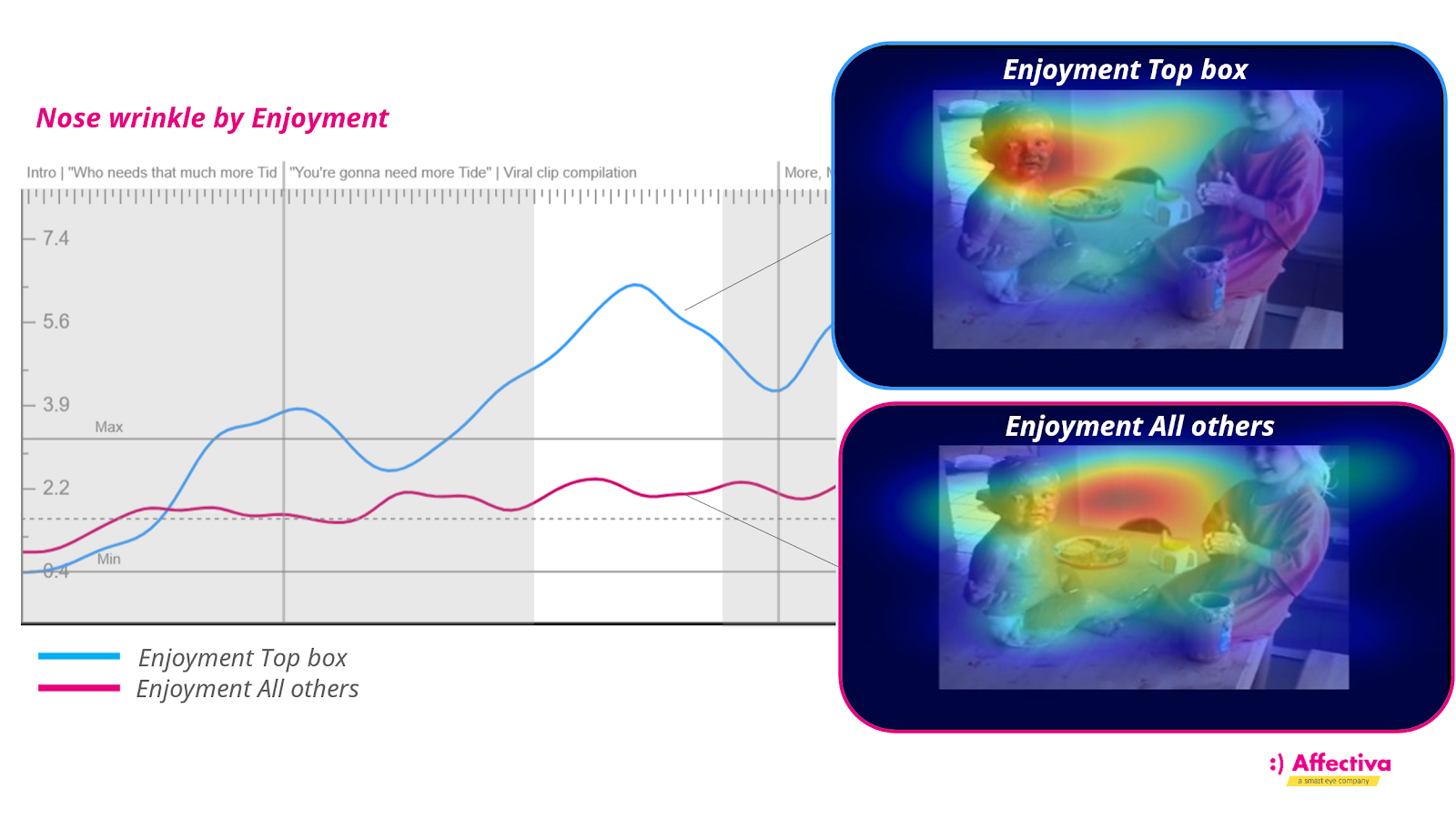
Why combine all these methodologies?
There are a multitude of benefits to adding multiple research outputs to the analysis. Using surveys alone is one dimension – giving you, as the researcher, a way of understanding what people feel.
Facial expression analysis provides a deeper knowledge of how people are feeling and can uncover synergies between emotions and the survey, or feelings that respondents are not able to articulate from the survey. And by having eye tracking, we can see where people are focusing as they view the content – are they paying attention to branding moments? Are they looking at important elements that are critical to the storyline or joke?
With You’re Gonna Need More Tide, our team at Affectiva Media Analytics you can unlock when deepdiving in the emotional engagement of the content and diagnose it further with the eye tracking analysis, and which is especially insightful that contain a complex narrative and visuals with specific elements important to ‘tell’ the story.
If you’re interested in learning more about our calibration-free eye tracking and how combining facial coding and eye tracking can amplify your analysis, check out our webinar which goes into more detail about the technology and other use cases.










